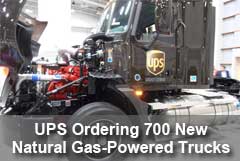TheGreenSupplyChain.com continues to believe that a move to broad use of natural gas-powered trucks will not only transform the trucking industry but also the US economy, as well as substantially reducing greenhouse gas emissions coming from the freight sector.
Will this sea-change occur? If so, how fast? These are the key questions.
Late last year, legendary energy investor T. Boone Pickens told Supply Chain Digest editor Dan Gilmore that with some government support in terms of low cost loans, there would be broad use of nat gas trucks in freight transportation in three to four years. Without it (and legislation to provide that support has died in Congress several times), Pickens said it would still happen, but perhaps take as long as seven to eight years. (See T. Boone Pickens on the Present and Future of Natural Gas Freight Trucks.)
But make no mistake about it, there continues to be lots of action pushing the technology forward. Proctor & Gamble, for example, has directed that 20% of its outbound shipments be pulled by gas-powered tractors. That has caused some existing P&G carriers to lose business because they lack natural gas powered tractors - and certainly given those carriers a push to also make the investments now.
Late in June, giant UPS upped the nat gas ante by announcing that all of the 700 Class 8 vehicles it has ordered for delivery late this year and into 2014 will run on liquefied natural gas (LNG). The order follows five years and 300 million miles of successful experience with 2,700 trucks and package cars fueled by natural gas, said David Abney, chief operating officer of the company.
The 700 LNG road tractors will use dual-fuel gas-and-diesel vehicles from Cummins Westport and Kenworth, as well as straight-gas engines, the latter spark-ignited Cummins model engines in Mack chassis. These are the first Macks built with Cummins' ISX12 G engines that are fueled by LNG instead of compressed natural gas (CNG).
Abney said in a recent industry presentation that UPS pays about $100,000 extra for a natural-gas powered tractor, substantially above the $30-35,000 premium typically cited. It is not clear why the discrepancy. Still, UPS believes the nat gas tractors will provide a payback on that investment over the long term.
 Currently, large fleets can buy LNG for as low as $1.50 per diesel-equivalent gallon , which is most attractive, almost $2.00 below contracted diesel prices and more than two dollars lower than on-the road-pricing. However, of course, the prices for natural gas and diesel can be quite volatile, so potential buyers need to add some sensitivity analysis to their calculations. Currently, large fleets can buy LNG for as low as $1.50 per diesel-equivalent gallon , which is most attractive, almost $2.00 below contracted diesel prices and more than two dollars lower than on-the road-pricing. However, of course, the prices for natural gas and diesel can be quite volatile, so potential buyers need to add some sensitivity analysis to their calculations.
But Abney thinks the government should take steps to reduce that delta between the costs to buy a nat gas truck and running natural gas powered trucks even more financial attractive. First, he would like to see the government wave the 12% federal excise tax on the extra costs for a tractor to make it be able to run on natural gas.
Second, he says the fuel tax formula needs to be changed. Currently, the federal tax is the same per gallon of diesel or LNG. Because a gallon of LNG contains less energy than a gallon of diesel, it makes the effective cost of LNG higher than it should be, Abney says.
"The map is greening, said Andy Douglas, truck maker Kenworth's national sales manager for specialty vehicles, at a dealer meeting last week, as he showed slides displaying areas with natural gas stations expanding around the United States. "It's no longer a science project. It's entering a mature state. This year, 3% to 4% of the truck build will be natural gas."
That's up from almost nothing for Class 8 trucks just a few years ago, but still shows that for now, traditional diesel is still dominating the new truck landscape.
How fast do you believe natural gas trucks will win market share? Let us know your thoughts at the Feedback button below.

|
|